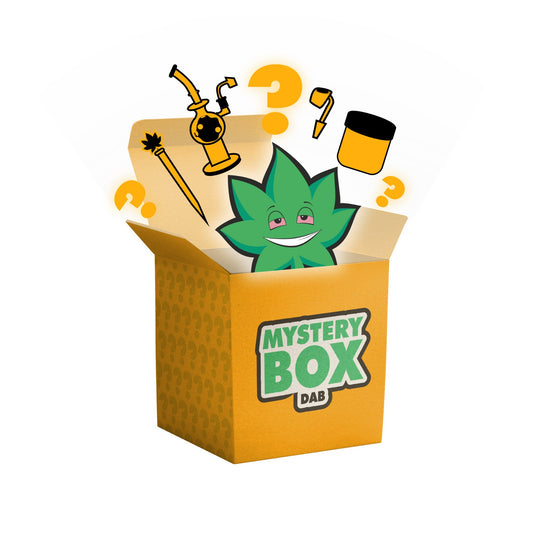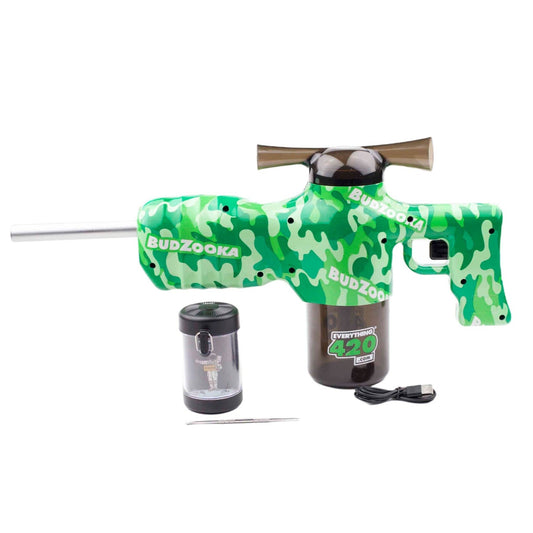Carbon dioxide, or CO2, is a gas that contains carbon and oxygen. While too much CO2 can be harmful to humans (and plants too), carbon dioxide is actually essential to plant growth because it produces carbohydrates which convert into energy, otherwise known as the process of photosynthesis. With increasing energy efficiency devices in our homes, that increases levels of CO2 that become trapped indoors and creates that stale air feeling. But when it comes to CO2 for dry herb plants, increased levels of CO2 can have a positive effect on plant growth, even with the same amount of average light. While methods that involve carbon dioxide are not recommended for beginners or even those that are currently gaining experience, using CO2 for plants can have great effects.
Is CO2 good for plants?
Not only is CO2 good for plants, but increasing CO2 for plants in a growing environment can have exponential benefits when it comes to yields. If plants were to ever be in a room where there is a lack of CO2, those plants would not be able to survive. Regardless of whether a plant is exposed to natural sunlight or lights from a bulb, all plants will absorb any light and use the carbon dioxide to create its own energy to grow. Thus, if there is more CO2 for plants in the air, the more energy a plant will have to grow and produce more yields in the end.
It might seem like it is a no-brainer to incorporate more CO2 for plants when it comes to its growth cycle, but there are definitely pros and cons to using CO2 for plant systems. It is not a miracle worker by any means, but more so science doing its thing. However, always keep in mind that too much of anything is never a good thing.
Pros of CO2 for plants
There are many benefits to using carbon dioxide systems for plants, but the main benefits are:
- Quicker growth. When a plant (or any plant) receives a trifecta of everything they need (increased light, increased nutrients, increased CO2) it will grow at a more rapid rate than it typically would. Consider it to be a plant that is bulking and taking in more carbs and protein to get bigger in a short amount of time.
- Increased yields. When using CO2 systems properly, increased CO2 for plant growth will offer bigger yields when flowering. If a grower does it correctly, CO2 for plants can increase yields by nearly 20% than the average growth cycle without increased carbon dioxide.
- Prevention from harmful risks. When using CO2 systems the grow area must be sealed, which prevents any insects or other harmful things that could affect a growth cycle. When a plant has a peaceful environment to grow in with enhanced carbon dioxide and sunlight levels, this growth space will be more like a sanctuary.
- Privacy and discretion. With having to seal up the grow space, not only does it protect the plants but it seals in the smell that dry herb plants give off - even in the growing process. If you can afford to implement CO2 systems then you can afford to have its own room or grow a tent that can be fully sealed for CO2 for plants to work.
- Customize room temperatures. If a grow space is sealed then the temperatures can be adjusted as well to fully maximize and mimic the ultimate growth space. Increasing temperatures in a grow room should help speed up the growth process and with some additional CO2 for plants that makes for a perfect duo.
Cons of CO2 for plants
There are a few downsides to using CO2 systems for plants, and anyone that is interested in getting into this kind of process should always know what they are getting into prior to actually executing it. Taking caution does not mean you should be weary of this process, but it is always a good idea to understand plants growth processes fully so you know what you are in for before you sign up to go through with it. Some cons to using CO2 for plants are:
- High Budget. Using CO2 for plant systems can become pretty costly, but most of the costs are upfront. Regardless, you will need some cash to properly execute this type of growth method, so be sure to calculate all the costs before actually going through with it if budget is your main concern.
- Mandatory sealed area. It is extremely important to seal the grow area where CO2 for plant systems is placed, as it can become very dangerous to human health if exposed to too much carbon dioxide - especially indoors. Make sure you can properly seal the grow area before committing to going through with this process, the last thing you want to do is make it a harmful space for others (or yourself) to be in.
- Strong lighting. With increased carbon dioxide levels there should be a strong amount of light to match that as well, so ensuring the correct lighting is set up is essential otherwise you will have an insufficient amount to properly benefit from using CO2 for plant systems.

Who should use CO2 for plants?
Only highly experienced growers should consider using CO2 for plants as this method is for seasoned growers who are well aware of the pros and cons to using CO2 for plant systems. Using carbon dioxide to grow plants quicker with increased yields is not something that beginners are equipped in experience to execute properly, and also something that beginners should not want to take on but instead should focus on growing the plant through a full cycle to gain some type of experience. Consider the following questions before setting out to use CO2 for plants:
- Does your grow room have ideal temperature conditions between 85 and 95 degrees Fahrenheit and be able to sustain this temperature range at all times?
- Are you able to control humidity levels and adjust according to each growth stage? For example, the vegetative stage will need higher humidity levels (about 70%) whereas the flowering stage does not need as much (lowered to around 60%) in order to give the plant an ideal environment to maximize growth and yields
- Are you aware of the growth control methods that should be used to increase yields?
- Can you control any nutrient deficiencies or pest issues from your grow room prior to adding CO2 for plants?
- Is your lighting situation optimized where your plant can absorb?
- Do you have enough CO2 to add to your grow room and be able to seal it?
How to use CO2 for plants in the vegetative and flowering stages?
There is more carbon dioxide in our air on earth than ever before, and while that is not a very good sign for humans, CO2 is essential to proper plant growth. Taking it even further by adding more CO2 for plants, this should lessen growth times and increase yields as long as light absorption and heat controlled temperatures are able to match the amount of CO2 each plant is intaking as well. You do not have to use much CO2 for plants to avoid risking your health, but this is why it is important to seal the grow area when using CO2 for plants systems because additional CO2 in an enclosed space over an extended period of time can be detrimental to human health.
During the vegetative stage, adding CO2 for plants can be very effective and speed up the growth process altogether if growers ever want to grow bigger plants in less than the time it normally takes. During this stage, keeping the CO2 for the plant system going during daytime hours will do the trick and it is as simple as that. It is best not to exceed the 800 ppm range because this will be a subtle boost without doing too much that might cause overkill.
The flowering stage is when CO2 levels will really kick into gear and increase, anywhere between 1,200 and 1,600 ppm. The level of CO2 where humans start to feel affected over a certain period of time would be starting at 1,000 ppm just as a helpful comparison.
What is PPM?
Carbon dioxide is typically measured in the percentage of air, or parts per million (ppm). Anything over 1,000 ppm in a closed room can be deemed potentially harmful, which is why it is important to monitor the PPM levels of carbon dioxide in a grow space. This is also why it must be sealed correctly for your own safety and for the CO2 enrichment process to actually be effective.
When to use CO2 in your grow room?
Some growers might not see too much of a difference when adding CO2 for plants during the vegetative stage, but the flowering stage should definitely show increased yields. CO2 for plants can be used during both the vegetive and flowering stage, about two weeks before harvest and yields are expected to show.
The CO2 for plants method can only be effective if the grow space can be sealed, proper lighting is available to the plant and other factors are not contributing to its possible lack of growth. Anything from plants receiving low levels of light, temperatures in the grow space are too cold, humidity is too high, and the air circulation is poor - any of these factors will prevent the addition of CO2 for to be effective for speedy growth and increasing yields.
Can you add too much CO2 to your plant?
A plant requires carbon dioxide during its growth cycle in order to convert light into energy and be able to move forward in its growth stages. If a plant does not receive enough CO2 with the amount of light it is absorbing along with the proper heat temperatures, its metabolism will start to decrease and eventually become unable to grow. If a plant receives too much carbon dioxide, it will also stop growing as well because it will almost act like it is in shock - because it is. CO2 for plants will only be effective if the proper amount of light is available, along with the correct heat conditions and humidity levels.
CO2 for plants can also become a very expensive method to implement as part of a growth cycle, especially if the grow room is a large area or working with multiple plants. Plants do not necessarily need too much carbon dioxide for it to be effective so it is best to make sure you can equip your plants with the right amounts and for the necessary amount of time before you dive in and realize it can be too much of a task!
Depending on how much light you have available to your plants is the amount of CO2 you will add to the grow space. If you are using LED lights, CDF lights of T5 lights then the natural CO2 found in fresh air is usually enough. This method can only work if you are able to control all elements in the grow space like the air, the light, and the temperature.
Do plants require CO2 at night?
Increasing CO2 for plant grow rooms can only be effective when done in the daytime and exposed to light, as plants exhale carbon dioxide during the nighttime. Continuing the process of adding in carbon dioxide during nighttime hours would be detrimental to the plant and would not be effective or helpful in any way. Plants need to breathe in oxygen at night and breathe out the carbon dioxide so it can properly release it back into the air and use it when light is present and has the ability to absorb more.
Why is CO2 enrichment only effective during the “day” period?
The daytime refers to when light is available to the plant, which is how photosynthesis occurs after the plant gets the proper CO2 and nutrients it needs to convert those carbohydrates into energy. CO2 enrichment can only happen during the day because at night, plants need to be breathing out carbon dioxide and inhaling oxygen instead to keep its growth cycle flowing. Just like you, plants need their rest and even if you are active and in the best shape of your life - you will need some sleep and rest at some point. No matter what good you are feeding into your body, your plants, etc. that will become useless if a living organism is unable to rest and give itself the reset it needs.
How to introduce additional CO2 to plants?

There are a few ways to implement additional CO2 for growth, and it really depends on the level of commitment, budget, and resources you have available to make each method work for you. Increasing CO2 levels to plants must also match the increased light available to the plant, proper temperature and humidity control, and the ability to seal the grow space so that CO2 will not leak out. Again, exposing additional carbon dioxide indoors to a sealed grow space can be very beneficial to the plant, but if it leaks out and contaminates with the air you are interacting with everyday it could potentially pose a health risk. It is extremely important to stress that adding more carbon dioxide to a grow space needs to be done correctly in order for it to be effective and not become a health risk for you as the grower. Try to consider this when choosing your grow space as well, if you are able to control that area and environment then the CO2 method should be a success. This is also the type of process where you will need to research (hence this article available to you), as well as learn as you go. Committing to additional CO2 for plants as part of your journey as a grower will show you something new every single growth cycle, and it will be pretty easy to tell whether the CO2 for plants method is right for you or not. Besides the upfront and long term costs associated with adding in CO2 for, there are other equipment and tools needed to make it possible that will be a necessary part of your plant’s success.
Compost
Using compost to add CO2 to plants is a very cost effective method, but not the most efficient in terms of helping a plant grow faster with increased yields. This method works best within smaller grow spaces, but what comes with this method is a very smelly grow space that might attract pests and produce mold more easily. Compost produces small amounts of CO2 and can be great for beginners that want to try their hand at being more sustainable and decreasing their waste, just be aware of what comes with working with compost especially in an indoor grow space.
CO2 bags
Another cost effective method for adding CO2 for growth, CO2 bags contain fungi that are growing in organic matter and thus producing CO2 to release into the air around it. Growing the fungi within CO2 bags can be pretty difficult so this method, while tempting for home growers on a budget, might not be the best option if you are a beginner and cannot consistently control the environment of your grow space. CO2 bags do not produce much carbon dioxide, even if you do know how to grow the fungi properly so if you are using this method for multiple plants in a bigger grow space it will probably not be as effective and most growers find themselves needing more CO2 bags than they anticipate.
CO2 tanks
Most growers that are working with small spaces will go with CO2 tanks that consist of carbon dioxide. You will need additional equipment to automate this type of tank since it is compressed carbon dioxide and does not produce heat but this can be an effective method for those that are again working with smaller grow spaces and do not need a bigger setup. Other equipment includes regulators and monitors to measure levels of CO2 in a grow space so you know exactly what each plant is receiving.
CO2 generators
Probably the most effective method for adding carbon dioxide to a grow room, CO2 generators operate by burning propane to produce heat and is the best option for those working with a large grow space. They are very easy to use but can be expensive as well combined with the need for propane. CO2 generators are for more experienced growers that are already experienced with adding carbon dioxide to their plants so this is more of an investment option for those that know what they are getting into. This is not the most economical and in fact is burning fossil fuels that will leave carbon residue in plants and is typically something that professional growers use because they know what they are doing and the risks they are taking as this method can create monoxide levels that might become potentially harmful.
Bottled CO2 for plants
This can be an inexpensive method for a small grow space, but depending on how long you are using it throughout the plant growth cycle it can become expensive as it will need to be replaced just about every week. Bottled CO2 is just pressurized carbon dioxide that will be slowly released into the air over time so while it is a great way to know exactly the amount of CO2 being released into the grow space, it can become costly if needing to use multiple CO2 bottles for an extended period of time.
CO2 for plants safety
It is extremely important to understand the risks you are taking when working with carbon dioxide and implementing more CO2 for plants. Many home growers decide to do this in a small grow space as an experiment but it can definitely show benefits for growers on a larger scale that will use this in their growth cycles over and over. Knowing the right safety precautions to take is best so you are aware of anything out of the ordinary or if something needs adjustment. Having the following equipment will ensure that your grow space has safety measures in place:
- CO2 monitors and regulators. It is best to have CO2 monitors and CO2 regulators to know how much carbon dioxide is in the grow space. Having equipment that measures CO2, humidity and temperature levels with sensors to alert you of all environmental factors you need to be aware of should not only give you a peace of mind but will give you accurate measuring at any point in the growth cycle process.
- Air flows, pressures, valves. All of this is important to have in a CO2 for setup because it will all come together in properly monitoring and administering the necessary amounts of carbon dioxide and when.
The setup for adding carbon dioxide to a grow space is similar to how beer and soda systems are set up to add CO2 as an enrichment process as well. This can help when doing other research in figuring out which equipment is best for you.
Carbon dioxide levels, depending on the plant’s stage of growth, should be between 800 ppm and 1500 ppm for indoor spaces. If you are working with larger spaces and those levels increase, be mindful to increase temperatures and light as well.
Since CO2 enrichment must not happen at night, it is also best to have the proper equipment that can turn off the carbon dioxide machines and keep its levels at a minimum so plants can do their thing when the lights go off.
Tips for increasing CO2 in the garden
Whether you choose to work indoors or outdoors, CO2 enrichment is most beneficial in sealed grow spaces where the environment can be best controlled by the grower. Carbon dioxide is not the only thing you need to pay attention to when executing this process, but the humidity and temperature levels, amount of light, and safety using carbon dioxide matters. Here are a few tips and tricks to easily add CO2 for gardens no matter what method you decide to try.
Humidity levels and temperature control
Ensuring the proper humidity levels and temperature is important because without this, the plant will not be able to properly grow. CO2 enrichment can only work when it is the only limiting factor, but if you have a grow space where you cannot control the light, temperature, and humidity - it can potentially pose a problem if it is not in line with the amount of carbon dioxide in the air. Humidity levels should be between 40-60% depending on which growth stage the plants are in, but do not fall below 40% or that could be harmful to the plant. Using dehumidifiers can also help in recycling the air better as fans typically waste more carbon dioxide over time.
Adding iron to plant diet
What also helps a plant to quicken photosynthesis is an increase in iron absorption because it acts as a catalyst in producing chlorophyll. The right nutrients will make a huge difference in plant growth, then introducing additional CO2 for will allow the plant to intake it completely and have enough energy to grow and increase yields. Ultimately, you as the grower are setting your plants up for success by feeding it proper meals and giving it a good home to live and thrive in.
Investing in proper equipment
If you decide to go this route of adding carbon dioxide to your grow room, you should definitely invest in the right equipment so you can properly execute this process. The right lighting, carbon dioxide equipment, monitors, regulators, tubes, etc. - it will be a lot to take on in the beginning, but once you see the potential of boosting yields and the quality of each plant it will be hard to go back to another way of growing.
Final thoughts: CO2 for plants
CO2 enhancement is not for every grower, especially any home growers that are on a beginners level. This is said with the utmost love, because implementing CO2 for plant systems is not for the faint hearted and no one is trying to discourage others from growing their own plant and this process might do that if you are unprepared for it. Using CO2 takes a vast amount of knowledge and understanding how carbon dioxide enhancement can benefit a plant growth cycle if integrated properly. There are many ways to add carbon dioxide to a grow space, depending on a grower’s budget and environment they are growing their plants in. Again, CO2 enhancement processes can only be effective if the grow room can be sealed to avoid any leaks and to also contain the additional carbon dioxide in the air so each plant can properly absorb it. The addition of carbon dioxide as part of a plant growth cycle can be highly beneficial for plant growth and its yields, so long as it gets the necessary amounts of CO2 and it is not overdone. Measuring levels of carbon dioxide and monitoring signs of plant growth will show just how much CO2 it needs or does not need, plus let you know if ppm levels are too high.
We are happy to put you to more knowledge about and educate you on how to properly grow your own plants. Our EF420 story backs up our need to put every stoner on to the good stuff, for the love of buds. We pride ourselves on excellent customer service because we are just like you and know what it feels like to be a stoner customer ourselves. Got any questions about how we run things around here? Check out the EF420 FAQs so you know exactly what we are about, and are happy to chat if you are curious about anything else! We are proud of you for getting this far and know you are well on your way to becoming the best grower you can be.










































































































